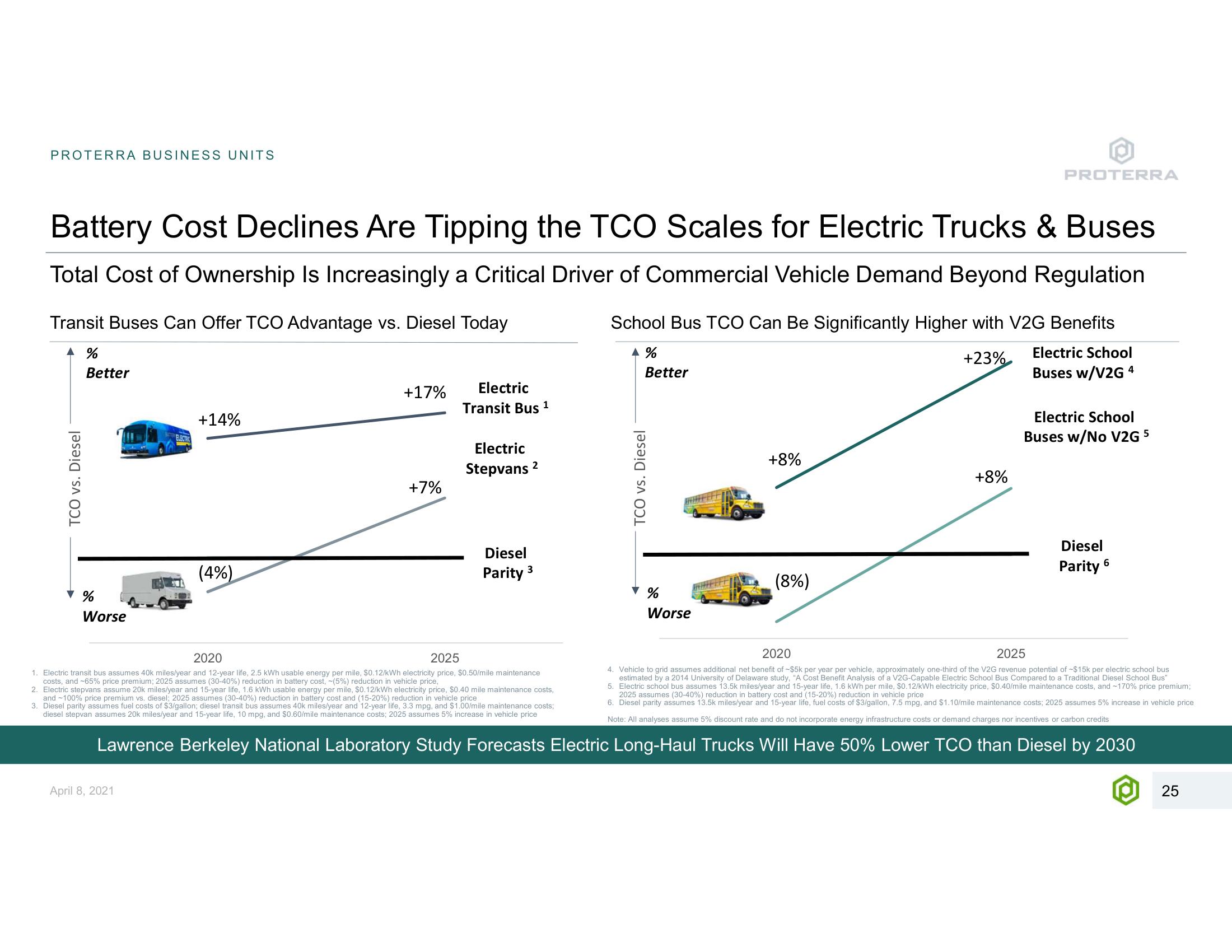Proterra SPAC Presentation Deck
PROTERRA BUSINESS UNITS
Battery Cost Declines Are Tipping the TCO Scales for Electric Trucks & Buses
Total Cost of Ownership Is Increasingly a Critical Driver of Commercial Vehicle Demand Beyond Regulation
Transit Buses Can Offer TCO Advantage vs. Diesel Today
School Bus TCO Can Be Significantly Higher with V2G Benefits
%
Better
%
Better
+23%
Electric School
Buses w/V2G 4
TCO vs. Diesel
▼ %
Worse
+14%
(4%)
+17%
April 8, 2021
+7%
Electric
Transit Bus 1
Electric
Stepvans
Diesel
Parity
2
3
2020
2025
1. Electric transit bus assumes 40k miles/year and 12-year life, 2.5 kWh usable energy per mile, $0.12/kWh electricity price, $0.50/mile maintenance
costs, and -65% price premium; 2025 assumes (30-40%) reduction in battery cost, -(5%) reduction in vehicle price,
2. Electric stepvans assume 20k miles/year and 15-year life, 1.6 kWh usable energy per mile, $0.12/kWh electricity price, $0.40 mile maintenance costs,
and 100% price premium vs. diesel; 2025 assumes (30-40%) reduction in battery cost and (15-20%) reduction in vehicle price
3. Diesel parity assumes fuel costs of $3/gallon; diesel transit bus assumes 40k miles/year and 12-year life, 3.3 mpg, and $1.00/mile maintenance costs;
diesel stepvan assumes 20k miles/year and 15-year life, 10 mpg, and $0.60/mile maintenance costs; 2025 assumes 5% increase in vehicle price
TCO vs. Diesel
%
Worse
+8%
(8%)
PROTERRA
+8%
2020
2025
4. Vehicle to grid assumes additional net benefit of -$5k per year per vehicle, approximately one-third of the V2G revenue potential of -$15k per electric school bus
estimated by a 2014 University of Delaware study, "A Cost Benefit Analysis of a V2G-Capable Electric School Bus Compared to a Traditional Diesel School Bus"
5. Electric school bus assumes 13.5k miles/year and 15-year life, 1.6 kWh per mile, $0.12/kWh electricity price, $0.40/mile maintenance costs, and -170% price premium;
2025 assumes (30-40%) reduction in battery cost and (15-20%) reduction in vehicle price
6. Diesel parity assumes 13.5k miles/year and 15-year life, fuel costs of $3/gallon, 7.5 mpg, and $1.10/mile maintenance costs; 2025 assumes 5% increase in vehicle price
Note: All analyses assume 5% discount rate and do not incorporate energy infrastructure costs or demand charges nor incentives or carbon credits
Lawrence Berkeley National Laboratory Study Forecasts Electric Long-Haul Trucks Will Have 50% Lower TCO than Diesel by 2030
Electric School
Buses w/No V2G 5
Diesel
Parity 6
25View entire presentation